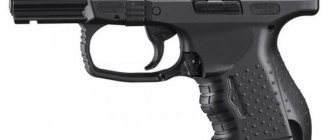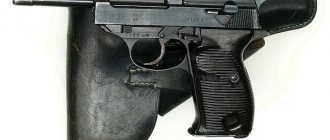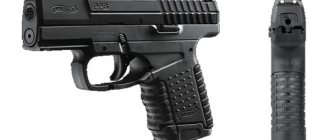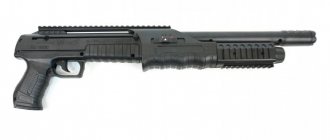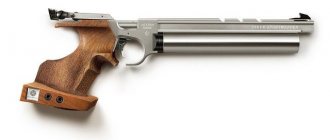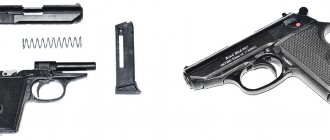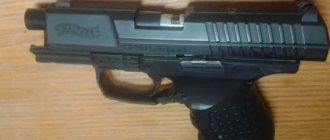Semi-automatic pistol
| Walter P88 | |
| P88 with wooden handles Nill | |
| Type | Semi-automatic pistol |
| Place of origin | West Germany |
| Production history | |
| Designer | Carl Walther GmbH |
| Developed | c. 1983 (Walther XM9) [1] |
| Manufacturer | Carl Walther GmbH |
| Produced | c. 1983-1984 (XM9 samples) c. 1986/87-1996 (P88 standard, first available on the market in 1988) 1992-2000 (P88 Compact) |
| Options | P88 Compact, P88 Champion, P88 Sport |
| Characteristics | |
| Weight | 895 g (31.6 oz) |
| Length | P88: 187 mm (7.4 in) P88 Compact: 181 mm (7.1 in) |
| Barrel length | P88: 102 mm (4.0 in) P88 Compact: 97 mm (3.8 in) |
| Cartridge | 9×19mm Parabellum .22 Long Rifle |
| Action | Short recoil, bolt closed. |
| Effective firing range | 60 m, 67 yd (9×19mm Parabellum) |
| Feeding system | 15-round detachable box magazine |
| Attractions | Front blade, rear cutout |
P88 Walther
is a semi-automatic pistol developed by the Walther company of Germany. Its main feature is a high-capacity, double-stack magazine designed for military and law enforcement use.
Review[edit]
To save weight, the handle is made of duralumin. Walther was able to take advantage of over 50 years of experience with the Walther P1 aluminum handle, which initially did not provide the required tear and abrasion resistance.
The Walther P88 uses a modified Browning system rather than the Walther P38 (or P1) deadbolt lock. The reasons for this were that with this type of bolt and barrel support, specially improved by Walther for the P88, higher shot accuracy could be achieved, a narrower bolt design and easier production.
The Walther P88 was primarily designed as a sidearm for military and law enforcement use. With the P88, Walther intended to offer the German armed forces an adequate successor to the aging Walther P1. The designation "88" was chosen when civilian marketing began in 1986/1987, in conjunction with the 50th anniversary of the legendary Walther P38. This was also Walther's contribution to the US Army's JSSAP XM9 handgun testing. [2] [3]
Operating principle
The drum loaded with bullets is placed in the charging chamber. To do this, lower the black lever located on the left, above the trigger guard. The bolt frame moves forward. You must return it to its original position manually:
- Press the button at the base of the trigger guard on the right.
- Remove the left plastic handle cover.
- Lower the lower plane of the handle protruding forward.
- Place the siphon bottle in the compartment and tighten it with the head of the bronze screw.
- Snap the bottom plane, thereby finally pinning the can onto the receiving needle.
- Place the decorative trim in place.
The gun is ready to fire. If you did not lift the safety lever up, then the intermediate firing pin is located on the line of impact with the trigger. You can shoot by self-cocking or by manually cocking the trigger.
When you pull the trigger, two things happen:
- turning the drum and pressing it towards the bore;
- cocking the hammer and its breaking from the sear's combat hook (or simply breaking if the hammer is cocked).
The trigger hits the intermediate striker, which presses on the valve stem of the expansion chamber of the gas system. A portion of gas enters a spring-loaded spool located in the bypass chamber and pushes the bullet from the drum along the barrel bore. The next time you pull the trigger, the firing cycle repeats.
In the video, the Umarex Walther CP88 Competition air pistol
Options [edit]
P88 standard[edit]
The Walther P88 participated in the third and final testing of the JSSAP XM9 pistol, conducted intermittently from 1983 to 1984. During testing, the Walther P88 was removed from consideration for failing to meet several of the 72 required conditions. First, it lacked the specified manual safety feature. Additionally, the P88 failed drop testing, with sights flying off and pistol frames cracking from 7,000 rounds of continuous fire. [4] [1] P88 also failed wet and dry mud testing. [5] The M9 pistol would ultimately be the Beretta 92F (92SB-F).
Sales of the standard model began in 1988 for the 50th anniversary of the legendary Walther P38.
The Walther P88 also participated in the 1990 Bundeswehr pistol testing conducted by the WTD91. Again, it was rejected due to lack of manual security. [6] [7]
Walther discontinued the standard version in 1996. Production of the P88 Compact - a slightly smaller and lighter version that was also cheaper to produce - continued until 2000. In 1997, after the standard model was discontinued, Carl Walther GmbH introduced the p88's successor, the Walther P99, to the markets.
P88 Compact[edit]
Walther P88 Compact
The Compact is lighter and slightly smaller with minor differences.
The Walther P88 Browning-Petter matched system was retained. The activation spring no longer consisted of one solid wire, but rather three thinner individual wires twisted together. These stranded springs of comparable cross-section have a slightly lower spring rate due to lower edge stresses, which counteracts material fatigue.
The standard P88 was heavily criticized for being bulky, heavy and expensive; The compact solved some of these problems.
Significant technical changes have taken place in the safety system: instead of a single control lever and 4 automatically operating safety devices, a “manual” safety device has again been built into the bolt. The reason for this was the police and military tenders, which were exactly what they were called. The “manual” safety complemented the positive vertical flap, automatically controlled by the trigger, with a longitudinal firing pin lock (safety No. 1 on the Walther P88) with a purely form-fitting firing pin lock. As with the Walther P38, Walther PP and Walther PPK, this safety device also again functions as a hammer release.
Both the standard and compact models are completely ambidextrous except for the bolt lock/release.
After the Bundeswehr initially rejected the P88 Walther, the "Compact" was subsequently introduced during subsequent pistol trials which continued until 1993. The Compact variant lost to Heckler & Koch's P8, which had a slightly modified USP with regard to barrel bearings, manual safety and store design. [8] Price also played a big role in the P88 Compact not being chosen. The USP list price was around DM 1,000 at the end of 1992; price of Walther P88 “Compact” is slightly less than DM 1800 [9]
In 2000, production of the Walther P88 "Compact" was stopped approximately 2 hours after production began. 7,000 purely commercial units were produced.
P88 Competition[edit]
Produced from 1993 to 2000, it was a sports version of the Compact model with a barrel length of 101 mm. The locking system is "Compact", but the trigger (DA) was not used. The automatic non-positive vertical safety device (No. 1) and the hammer relaxation device were also not used. Manual fixation with neutral force was maintained. The trigger is released after moving 3.3 mm. The standard peel resistance is 14 N, but can be individually reduced to approx. 10 N with Walther spring kit. The trigger stop was still adjustable via an adjustable set screw, as was the case with the Walther P88 utility models. [10]
Accessories [edit]
For all variants of the Walther P88, Nill continues to produce wooden handles with and without thumbrest. The already very good hand position with standard plastic scale handles can be further optimized with slightly larger wooden scales.
Specifications
Technical characteristics of the Walther CP 88 Competition Black air pistols:
| Characteristics | Indicators |
| Mechanism type | Gas bottled CO2 |
| Caliber, mm | 4,5 |
| Trunk | Steel, rifled |
| Charging method | Revolving drum |
| Ammunition | Lead bullet |
| Drum capacity | 8 bullets |
| CO2 cylinder capacity, grams | 12 |
| Number of shots per fill | 100-120 |
| Shot speed, m/s | 130 |
| Power, J | 3-4 |
| Blowback | No |
| Trigger | Self-cocking or manual |
| Barrel length, mm | 143,1 |
| Overall length of the gun, mm | 230 |
| Weight with equipped drum and cylinder | 1150 grams |
Reception and legacy[edit]
The Walther P88 is highly sought after by collectors and sport shooters for its accuracy (40 to 50 mm [1.5 to 2 in] groups at 20 m [25 yds]) and high-quality construction. [ citation needed
]
The successor to the Walther P88 was the Walther P99, developed in 1994 and introduced in 1997, with production beginning the same year. [12] The standard P88 was discontinued a year earlier in 1996. The P99 solved various problems of the P88 and became a much more successful pistol. [ citation needed
]
Options and modifications
After the war, the 38th received a number of modifications and improvements. In addition, it was produced in versions chambered for a traumatic cartridge, as well as for firing gas.
Combat version
In 1957, the P38 was put back into production for the newly created West German Army. Sometime between 1961 and 1963, the nomenclature changed and the version made for military and police use was known as the “P1” model, identified by the P1 stamp on the slide. Most post-war pistols, whether P38 or P1, have an aluminum frame rather than the original steel frame design.
In the 1970s, German police began to accept other pistols throughout Germany - including the Walther P4 (short-barreled version of the P1), Walther P5 (inspired by but different from the P1).
Walther traumatic pistol
The Walter traumatic pistol, which is called Erma-38R, cannot be confidently called a modification, since this weapon is not a remake of the combat version, but is produced from scratch. The design, in some respects, differs from the original. For example, the location of the return spring does not correspond to the original.
Of course, there are changes associated with adaptation to a traumatic cartridge. In some places, alloys are used instead of steel. Manufactured in Ukraine, currently discontinued.
Air pistol walther p38
The Umarex Walther p38 air pistol has a twenty-round magazine and is equipped with a blow back system (moving bolt). Unlike the combat prototype, it has a single action trigger. Pneumatics have a bullet flight speed of 120 m/s.
Powered by CO2 and has a removable barrel. Along with this model, the maruzen p38 model is also produced, which runs on green gas.
Gas pistols
The Erma 38G product is essentially identical to the Erma-38R traumatic pistol, since both of them were manufactured by the same company. The only difference is the type of ammunition. A 9 (mm) caliber gas cartridge is used. Just like Erma-38R, discontinued.
Using a Walther P 38 pistol
The primary purpose of the Walther P38 is as a military secondary weapon. During World War II it was the main pistol of the Third Reich. After the war it was supplied mainly to the police. Rare, but is a reward weapon.
Walther PP pistol
The first pistol in the PP series ( Polizeipistole
), from the name it is clear that it was primarily intended for the police. It was released in 1929. It has a large number of modifications.
Pistol Walther P5
Developed by Walther in 1979. Manufactured for arming the German police. Caliber 9x19 parabellum. A distinctive feature is left-handed case extraction.
Pistol Walther P22
Very similar to Walther P99. Walther Industries calls it the “little brother of the P99.” Uses 22LR cartridge. For convenience when shooting, it has replaceable grip pads.
Walther P88 pistol
It was developed as a weapon for the army and police. Participated in a competition for a pistol to supply the US Army, but lost to the Italian Beretta. It was not successful, mainly because of the high cost.
Walther P99 pistol
Development of the P99 began in 1994, and the modern pistol was introduced in 1996. The main goal was to develop a new, modern weapon for police and self-defense, which would include all the latest developments and would be cheaper than its predecessor, the Walther P88, which did not achieve any significant commercial success, mainly due to high prices . Option Q is used by the Dutch police and some German police forces.
Links[edit]
- IWS 2/1983: Die neue Walther P88
- IWS 2/1983: Die neue Walther P88
- Deutsches Waffen-Journal 4/1985: P88 - die Neue Selbstladepistole von Walther
- https://www.waltherforums.com/threads/p88-failure-to-pass-drop-test.6308/
- McClellan, Angus. "25 years of service for the Beretta M9" (PDF).
- IWS 2/1983: Die neue Walther P88
- Deutsches Waffen-Journal 4/1985: P88 - die Neue Selbstladepistole von Walther
- Heckler & Koch Global. "Pistol R8". Archived from the original on September 1, 2008. Retrieved July 28, 2008.
- Deutsches Waffen-Journal 8/1992: Walter P88 Compact - die große Kleine
- Deutsches Waffen-Journal 6/1994: Für Experten - Walther P88 competition
- https://www.umarex.com/products/airguns/co2/416.00.00.html
- "Walther P99 in World Guns". Archived from the original on 2010-09-14. Retrieved November 24, 2014.
Umarex Walther CP88 - a good choice for target shooting
Country of origin: Germany Type: gas cylinder (CO2) Caliber: 4.5 Magazine capacity: drum for 8 bullets Barrel type: rifled Rear sight: horizontally adjustable Front sight: non-adjustable Length: 180 mm Barrel length: 90.9 mm Weight: 1, 04 kg Frame and bolt material: silumin Initial bullet speed: about 120 m/s Trigger: single and double action Blowback: no Cylinder is enough: about 80 shots Estimated price at the time of writing: about 8,000 rubles
The pistol is a licensed copy of the German military police pistol Walther P88 Compact. Moreover, it should be noted that the copy is very, very high quality. Externally, the pistol completely copies its combat brother - all external structural elements are in place. It is also a twin of its ancestor in size, as well as in weight.
I would like to say something about weight separately. Such a high mass of the pistol is due to the use of silumin, an alloy of aluminum and silicon, as a material for the body. It is thanks to this that Walter’s weight is more than a kilogram, but it also forces him to be handled with due care - after all, silumin is a rather fragile material, and is not intended for throwing onto asphalt and driving nails. But what weapons can be handled carelessly? That's the same!
A small amount of plastic is still present in the design of the pistol - it is from this that the linings on the pistol handle are made. But, first things first – we’ll come back to them later.
Despite the high degree of external similarity of the pistol with its combat copy, many of its elements either perform completely different functions or are completely decorative. For example, the bolt stop lever is merely a decorative element, while the bolt release lever actually provides access to a drum-type magazine, and the pseudo-ambient magazine release button unexpectedly drops the left grip pad, allowing access to the gas cylinder.
But the fuse is not only fully functional, but also double-sided - which is good news!
By the way, about the fuse. It is made on the principle of not blocking the trigger, which often leads to its breakdown, but by turning the shock rod of the air valve away from the trigger. Which is quite convenient and allows you to easily remove the pistol from pre-cocking.
The false clip ejection button actually serves to disconnect the left handle pad, under which, in fact, the gas cartridge is inserted. The cylinder clamping screw is hidden and a folding “magazine heel” is used to pierce the cylinder. It is made very conveniently, but during shooting you need to be careful not to accidentally flip it back, thereby releasing the gas.
Although, I must admit, this is difficult to do and there is absolutely no such desire - the design is really convenient and reliable. The only thing that frightens us is the possible prospect of the plastic lining becoming loose and causing it to play, but only time will tell to what extent this fear is justified.
A few words about sighting devices. The front and rear sights are quite high. The rear sight is adjustable horizontally with the included key. There are no bright markings on the sights, so in certain conditions it may seem relatively awkward. Instead of a rear sight, you can buy and install a collimator or optical sight. To do this, you need to remove the rear sight and install a bar in its place, onto which, in fact, additional sighting devices are attached.
Since the pistol shoots not with balls, but with bullets, its magazine is designed in the form of a classic 8-round revolver clip-drum, of which two are included with the pistol.
The magazine is accessed by pressing the bolt release lever. The magazine must be taken out very carefully - holding the pistol strictly vertically, because when tilted there is a high chance of the drum rolling out of the pistol onto the ground with all that it entails.
The trigger mechanism of the pistol is both double and single action. Shooting is possible both with and without pre-cocking the hammer.
When shooting with self-cocking, the trigger stroke, although soft and even, is quite heavy and long. When firing with pre-cocking, the force is noticeably lower.
The accuracy and accuracy when shooting from 10 meters is excellent - especially when pre-cocked, the sight in my copy (unlike many reviews) is adjusted “to the bull’s eye”. In my opinion, you simply cannot find a better choice for targeted shooting for the money!
Gas consumption is about 80 shots (I used Crosman cylinders), which is very, very cool. It should be noted that I was very pleased with the cylinders - not one of the 20 cylinders purchased had any burrs, sharp points or other defects that could spoil the gasket of the gun. Very stable - the number of shots did not change noticeably from cylinder to cylinder.
The pistol is packed in a nice plastic case and equipped with two interchangeable magazines and a key for adjusting the rear sight.
For shooting I used Umarex Cobra and RWS Club .
About the first ones, I must say that I didn’t like them at all. The size is right on target. They often jammed - for some unknown reason they remained in the drum, I think they were sitting too tightly. Out of 100 bullets, about 15 did not fire, they got stuck, one was too small and simply fell out, and about 3 were defective - dented and uneven. But, it should be noted, they penetrate perfectly. At a distance of 10 meters, a matchbox filled with napkins is pierced right through and very carefully, sharp small holes are left in the targets, a plastic half-liter bottle is not pierced by ricocheting, but aluminum cans are hit right through “with a bang.” Just like a bottle cap - it gets trashed on the second hit! It's a shame that the quality suffers. A few words about cleanliness - there is no lead dust in the box, but there are lead fragments on the bullets themselves - noticeable, so they can simply be removed with a fingernail. I don't think it's critical.
But RWS Club was frankly pleased! At a distance of 10 meters, targets are hit perfectly, leaving a clear mark - so there are no questions about the exact location of the impact, plastic half-liter bottles naturally ricochet well, aluminum cans are pierced right through or only on one side - depending on your luck. And even from the edge! They don’t mutilate a plastic bottle cap, but they tear to hell a box full of napkins. And, in fact, the pistol fits perfectly in the magazine - there are no complaints about the quality of any of the bullets! Extremely clean and tidy!
A little more about ergonomics. As I already said, the pistol sits very comfortably in the hand. Despite its weight, it is very pleasant to hold. Balanced perfectly. Still more suitable for shooting with two hands. Plastic pads do not distract in any way, the hand does not sweat. If desired, you can replace them with wooden ones. Despite the difficult descent, you quickly get used to it.
The quality of workmanship is beyond praise! The pistol is designed for 7-8 thousand shots.
The volume deserves a special mention. Because Walter’s is quite large. You still have to get used to these pops, which are so unusual for pneumatics. They are especially loud when using pre-cocking. Some will write this down as a plus of the model, others as a minus.
And a little about the disadvantages. They still exist. What immediately catches your eye is that the paint is not of the highest quality - I think it won’t last long, because it’s starting to wear off on the holster. I was a little confused by the through gaps - for example, under the bolt frame. But I don't think this is critical. Also among the minor disadvantages I would include the entirely black front and rear sights. And the main disadvantage of the pistol, of course, is not the low price at all, but this sin is common to all models of this Umarex line.
In general, the pistol is very, very worthy and definitely deserves the right to take its place in your collection! As I already said, you simply cannot find a better model for precision target shooting for that kind of money.
Tazeev Igor N.
VN:F [1.9.22_1171]
please wait...
Rating: 1.0/ 10 (votes: 2)
VN:F [1.9.22_1171]
Rating: 0 (from 0 votes)
Share the link to the article “Umarex Walther CP88 - a good choice for target shooting” with your friends:
